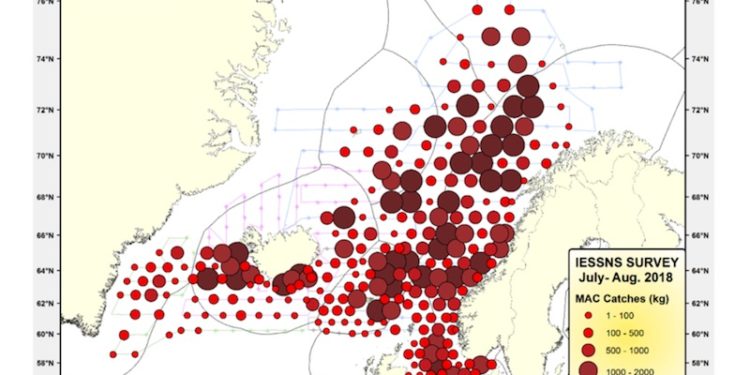Results of the ISSSNS joint pelagic survey carried out by Denmark, Norway, Iceland, Greenland and the Faroe Islands from 30th of June to 6th August have been released, and indicate a drop in the mackerel population, with the densest concentrations observed in the Norwegian Sea.
According to the report the 2018 index decreased 40% in biomass and decreased 30% in abundance compared to the 2017 index. This year’s survey showed that the most abundant year classes are 2010, 2011, 2014, 2016 and 2017 with 11%, 14%, 14%, 15% and 13% (in numbers). The incoming 2017-year class has the largest age-1 index value recorded in IESSNS and is 150 % larger than the incoming age-1 cohort in 2017. The mackerel cohort internal consistency remained relatively high.
The survey coverage area was 2.8 million square kilometres in 2018 which is the same as in 2017. Furthermore, 0.25 million square kilometre area was surveyed in the North Sea. Mackerel was observed in most of the survey area. Distribution zero boundaries were found in majority of survey area with a few exceptions of low mackerel abundance at the survey boundaries south of Faroe Island, and north and south of the strata adjacent to Greenland.
The mackerel appeared more evenly distributed within the survey area and with a more easterly distribution than in 2017. This difference in distribution primarily consists of a marked biomass decline in the west (76% decrease in biomass west of stratum 3). In the eastern areas, the decline was less (21%). Furthermore, there was also an eastward shift of distribution within the Norwegian Sea.
The mackerel biomass is estimated at 6.20 million tonnes, while the volume of Atlanto-Scandian herring also dropped with a biomass estimated at 4.50 million tonnes, a 24% reduction compared to 2017. The biomass of of one year and older blue whiting is estimated at 2 million tonnes, 11% down on 2017. The overall biomass index over the survey area is estimated to have fallen by one fifth, with large variations between areas, with an 18% increase compared to a fall in the Norwegian Sea and in Greenland waters.
Surface sea temperatures south and west of Iceland were 1-2°C lower than the long-term average and temperatures north of Iceland, east of Greenland and in the Norwegian Sea were shown to be 1-2°C higher than the long-term average over the last twenty years.
The survey results will be presented to ICES and are expected to be among the information sources used to estimate stock sizes and to produce advice for mackerel, herring and blue whiting catch levels that will be published on the 28th of September.









